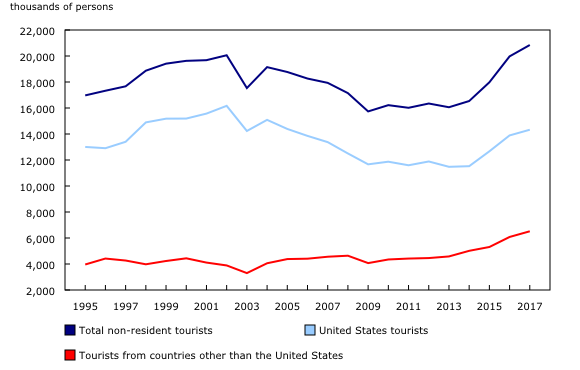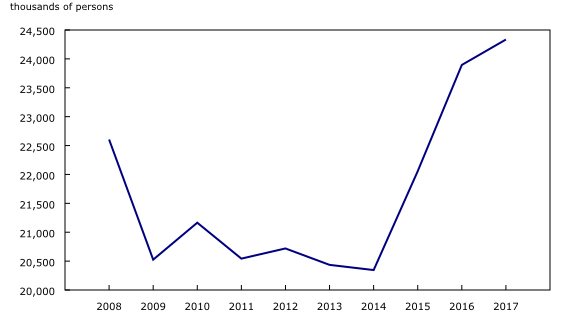Travel between Canada and other countries, December 2017
Archived Content
Information identified as archived is provided for reference, research or recordkeeping purposes. It is not subject to the Government of Canada Web Standards and has not been altered or updated since it was archived. Please "contact us" to request a format other than those available.
Released: 2018-02-20
Year-end review, 2017
Record number of tourists from abroad arrived in Canada in 2017
During the year of Canada 150 celebrations, international tourists made 20.8 million trips of one or more nights to Canada, up 4.4% from 2016 and a new annual record, surpassing the previous record of 20.1 million set in 2002.
This year-end review presents 2017 annual totals for travel (involving same-day and overnight trips) and tourism (involving overnight trips only). Figures are based on preliminary estimates of arrivals to Canada at certain airports during the latter months of 2017. These data are subject to revision. Please refer to the Note to readers for further details.
Tourists
The number of US tourists rose 3.1% in 2017 to reach 14.3 million, the highest figure since 2005. There were also a record 6.5 million tourists from overseas countries, up 7.2% from 2016.
Compared with the previous 2002 record, a greater share of tourists to Canada in 2017 were from countries other than the United States, the result of declines in tourism from the United States and an increase in the number of tourists from overseas.
In 2017, tourist arrivals from the United States, despite rising in each of the last four years, were still 11.4% below the high of 16.2 million reached in 2002. Meanwhile, arrivals from the rest of the world rose from 3.9 million in 2002 to 6.5 million in 2017 (+67.6%), including increases in each of the last eight years. As a result, residents of countries other than the United States, who represented only one in five international tourists to Canada in 2002, accounted for nearly one in three in 2017, the highest proportion on record.
Travellers
US travel to Canada increases for third straight year
US residents made 24.3 million same-day and overnight trips to Canada in 2017, up 1.8% from 2016. This was the third consecutive year of growth, following increases of 8.3% in 2016 and 8.4% in 2015.
Trips to Canada by car by US residents, which made up about two-thirds of total US trips to Canada in 2017, dropped 0.5% to 16.2 million following two years of growth. The number of overnight car trips remained unchanged from 2016 at 8.0 million. However, same-day car trips were down 0.9% to 8.2 million.
Trips by plane increased 6.6% to 5.7 million in 2017, the eighth consecutive year of increased plane travel to Canada by US residents. The proportion of US travellers to Canada arriving by plane has increased steadily over time. In 2002, plane trips accounted for about 1 in 10 (10.3%) US trips to Canada while, in 2017, nearly 1 in 4 trips (23.3%) to Canada by US residents were by plane, the highest proportion on record. This occurred as car trips decreased by half since 2002, led by declining same-day trips, while plane trips increased 34.0% during this period.
Record number of arrivals from overseas countries
A record 6.7 million travellers from overseas (countries other than the United States) arrived in Canada in 2017, up 6.6% from 2016. This marked the eighth consecutive year of increased travel to Canada by overseas residents, with volumes increasing by close to 60% since 2009.
There were year-over-year increases in travel from all continents, most notably a 26.1% increase from the region of North America, Central America and the Caribbean (excluding the United States) and a 19.0% increase from South America. These increases follow the lifting of visa requirements for travellers from Mexico in December 2016 and modifications to visa requirements for citizens of Brazil which took effect in May 2017. Excluding the United States, Mexico and Brazil are the two largest sources of travellers from the Americas.
The number of travellers to Canada from Asia rose 7.2% in 2017 to 2.3 million, more than twice the figure recorded in 2009. The number of travellers from Europe rose 1.7% from 2016 to 2.9 million, up 29.4% from 2009.
Travel by Canadians to the United States posts first increase in four years
Following three years of decline, the number of same-day and overnight trips to the United States by Canadian residents rose 2.7% in 2017 to 42.1 million, 25.1% fewer than in 2013 when the Canadian dollar was last on par with the US dollar. In 2017, the average value of the Canadian dollar was US$0.77, up slightly from an average of US$0.76 in 2016.
In 2017, overnight trips to the United States increased 4.8% to 20.2 million, after the number dipped below 20 million in 2016 for the first time since 2009.
Trips by car, which represent about three of every four trips by Canadian residents to the United States, increased 1.0% in 2017, to 32.2 million. However, this was 30.6% lower than the number of car trips to the United States in 2013. Overnight trips rose 1.7% in 2017 to 10.7 million while same-day trips rose 0.6% to 21.5 million.
Travel overseas by Canadians continues its upward climb
Canadian residents made a record 12.8 million trips to overseas countries in 2017, 7.2% more than in 2016. The number of Canadians travelling overseas has increased every year since 2003, rising 153.3% from 5.1 million over this period.
Monthly review, December 2017
In December, US residents took 2.0 million trips to Canada, 4.0% more than 12 months earlier but 1.9% fewer than in November. Both car trips and plane trips contributed to the decline from November. However, both car (+1.9%) and plane (+10.6%) trips increased from December 2016.
The number of trips in December from overseas countries (countries other than the United States) reached 566,000, down 6.9% from November but a 3.0% increase compared with December 2016.
Canadians made 3.6 million trips to the United States in December, edging down 0.1% from November but up 7.6% compared with December 2016. The trend was similar for travel overseas, as Canadians made 0.2% fewer trips in December compared with November, but 5.3% more than in December 2016. Canadians made a total of 1.1 million trips to overseas countries in December 2017.
Note to readers
Monthly data are seasonally adjusted. For information on seasonal adjustment, see Seasonally adjusted data – Frequently asked questions. Year-to-date figures are based on unadjusted data.
Seasonally adjusted data from January 2017 to November 2017 have been revised. No revisions were made to data that were not seasonally adjusted. No corrections were made to the previous month.
Data for Statistics Canada's Frontier Counts program are produced using administrative data received from the Canada Border Services Agency (CBSA) on all international travellers who have been cleared for entry or re-entry into Canada. This includes residents of Canada, the United States and overseas entering Canada from abroad.
In 2017, the CBSA began introducing the electronic Primary Inspection Kiosk (PIK) system at airports in Canada. The PIK system replaces the E-311 Declaration Cards that are completed by international travellers to Canada. As of the end of October, the PIK system was deployed at the following airports: Macdonald–Cartier, Ottawa (March 2017); Vancouver International Airport (April 2017); Toronto International Airport T3 (June 2017); Edmonton International Airport (September 2017); Stanfield International Airport, Halifax (October 2017); Pierre Elliott Trudeau International Airport, Montréal (November 2017); and Jean Lesage Airport, Québec (December 2017).
While awaiting receipt of PIK data, Statistics Canada prepared preliminary estimates for airports at which the PIK system has been deployed. These estimates are based on CBSA reports of total international travellers by airport, while the distribution between Canadian, American and travellers from individual overseas countries are modelled estimates based on historical data and trends, using methods similar to those used to do seasonal adjustment.
Once PIK data have been reviewed and processed, Statistics Canada will revise the preliminary estimates for these airports, as well as the provincial and national totals to which they contribute.
Overseas countries refer to countries other than the United States.
A Canadian resident traveller is a Canadian resident who has travelled outside Canada for a period of less than 12 months.
A non-resident traveller is a resident of a country other than Canada who is travelling to Canada for a period of less than 12 months.
An overnight traveller or a tourist is a traveller whose trip includes one or more night's stay.
Products
The December 2017 issue of International Travel: Advance Information, Vol. 33, no. 12 (66-001-P) is now available.
The updated Canada and the World Statistics Hub – United States (13-609-X) is now available from the home page of our website. This new product illustrates the nature and extent of Canada's economic and financial relationship with the United States, using interactive graphs and tables. This product provides easy access to information on trade, investment, employment and travel, including merchandise trade by Canadian provinces and US states.
Contact information
For more information, or to enquire about the concepts, methods or data quality of this release, contact us (toll-free 1-800-263-1136; 514-283-8300; STATCAN.infostats-infostats.STATCAN@canada.ca) or Media Relations (613-951-4636; STATCAN.mediahotline-ligneinfomedias.STATCAN@canada.ca).
- Date modified:







